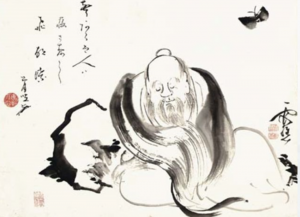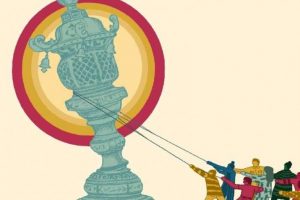
The Pure Land teaching is an easy and simple, joyful and fast way to gain buddhahood
The Pure Land body of teachings and the Pure Land school are centered on rebirth in Amitabha’s Land of Bliss. They are based on the three Pure Land Sutras: the Infinite Life Sutra, the Contemplation Sutra and the Amitabha Sutra. They were revealed by Shakyamuni Buddha, although they are not grouped in the category of scriptures that were spoken in the era of Shakyamuni.
Rebirth in Amitabha’s Land of Bliss is the primary way for ordinary beings to be liberated from the cycle of rebirth and for sacred beings to attain the stage of non-retrogression, so that they can achieve buddhahood with certainty. Thus, Pure Land is a Buddhist teaching for attaining perfect enlightenment, ultimate purity, eternal happiness, and thorough emancipation.
According to Amitabha’s Vows of Deliverance (the 18th, 19th and 20th Vows) and Shakyamuni’s elaboration in the Contemplation Sutra, there are two main ways to attain rebirth in the Land of Bliss. In the Commentary of the Contemplation Sutra by Master Shandao, one is known as the Path of Importance (based on the 19th and 20th Vows), and the other is the Path of Great Vow (based on the 18th Vow). It says:
The Path of Importance is the two teachings on meditative and non-meditative virtue, as expounded in the Contemplation Sutra. Meditative virtue means to still one’s anxiety by ceasing all thought, and non-meditative virtue means to eliminate evil and nurture goodness. This is the path if one dedicates these two virtues and aspires to be reborn [in Pure Land].
The Path of Great Vow is, as said in the Larger Sutra (the Infinite Life Sutra), “All good and evil ordinary beings will not attain rebirth [in the Pure Land] without recourse to the karmic power of Amitabha’s Great Vow as an augmentative cause.”
Both paths are regarded as Pure Land teachings.The name “Pure Land teachings”was first used by Master Daochuo (562–645 CE) in his book A Collection of Joy and Peace. In the same volume, he called all other Buddhist teachings the “Sacred Path teachings.”
The fountainhead of the Pure Land school
In the “Chapter of Easy Practice of the Discourse on the Ten Stages,” the Indian patriarch Nagarjuna Bodhisattva (c. 150–250 CE) identified the Pure Land teaching with its unique characteristic: “ease of practice.” He wrote:
There are infinite ways to access the Buddhist teachings; some are difficult and some are easy, like roads in the world. Walking by land is painful, but sailing by sea is joyful. It is similar to the bodhisattva path. Some may practice vigorously with due diligence, and some may take faith as an expedient means and reach a state of Aviniartaniya (non-retrogression) through easy practice.
Nagarjuna also said that faith is considered “expedient means” (the entry point) in the Pure Land teaching, and later identified “Name-Recitation in accordance with the Fundamental Vow” as an easy practice in his explanation of Amitabha’s 18th Vow in the same book:
Amitabha’s Fundamental Vow is as follows: “If anyone thinks of me, recites my name, and takes refuge in me, he will instantly enter the state of assurance [non-retrogression], and subsequently attain the highest perfect enlightenment.” For that reason, you should always be mindful of him.
Through his analysis of the Buddhist teachings, Nagarjuna identified Amitabha’s 18th Vow as the root and lifeline of the Pure Land teachings. Laying this solid foundation was an essential pre-requisite for the ultimate establishment of an independent school of Buddhism.
Later, Pure Land patriarchs such as Vasubandhu Bodhisattva (c. 4th–5th century CE) in India, and Master Tanluan (476–542 CE) and Master Daochuo in China, made further contributions as part of a budding lineage and formulated a system of teachings, principles, and practice so that Dharma practitioners can swiftly attain rebirth in the Pure Land and ultimately achieve buddhahood.
In the Tang dynasty, Master Shandao (613–81 CE) synthesized these strands of Pure Land thought into a coherent, systematic, and complete framework and established the Pure Land school in China. Thus, he is considered the de facto founder of the Pure Land school,the largest Buddhist tradition in East Asia.
Significance of lineage in the Pure Land teaching
The wisdom of the buddhas is profound; it is unfathomable to ignorant, ordinary beings like us. It is said: “The Buddha speaks the Dharma in a single phrase, while sentient beings can only understand according to their own aptitude and capacity.” In other words, the Buddhist teachings are multi-layered in their meanings, and people have many different interpretations. It is difficult for Dharma learners to follow as they are easily confused by all these commentaries on different approaches and perspectives.
With the inauguration of the school, Master Shandao provides all practitioners the clearest and the simplest explications of the Pure Land teachings so that they may joyfully learn and easily follow the guidelines for practice. As the tradition synthesized by Master Shandao provides the correct interpretation of the Pure Land sutras, practitioners can follow the guidelines in study and practice without losing right mindfulness, or becoming distracted.
Pure Land practitioners should follow only the explications of Master Shandao as they are definitive for all time and are validated by all buddhas.
If the interpretations of other knowledgeable figures differ from those of our lineage masters, we should recognize that the others were using their own expedient means to attract and instruct learners. We should neither comment on nor seek convergence with these other teachings, but merely set them aside. This is the proper approach for practitioners of the Pure Land school toward such matters.
Master Huijing, the Pure Land Dharma master in the Shandao lineage today, writes in the tenets and traditions of the Pure Land school about “Respect [for] the Lineage”:
Our writings and discourses must stick conscientiously to our lineage. We must never presume to break tradition with our own elaborations of the teachings. Where the thought and perspective of other schools and lineages differ from ours, respect them but do not follow them. We should firmly uphold our own tradition.













